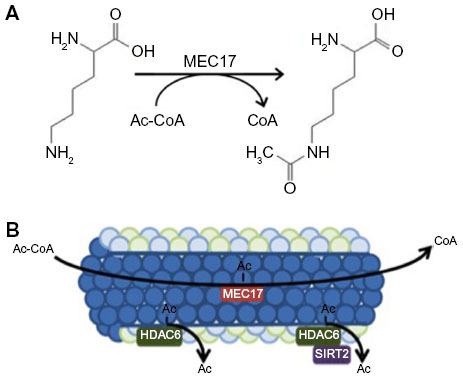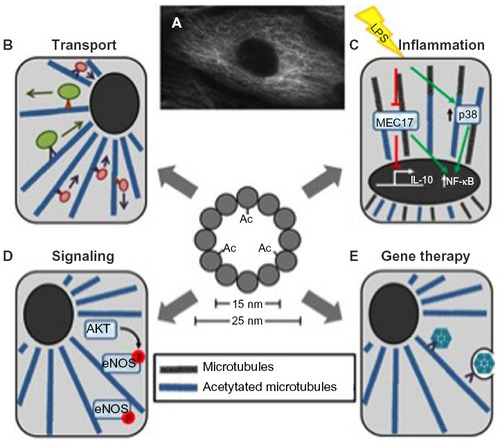Figures & data
Figure 1 Acetylation mechanisms.
Notes: (A) Schematic diagram of acetylation on lysine-40 of alpha-tubulin by MEC17. The acetyl group is provided by cofactor Ac-CoA. (B) Regulation of acetylation levels by MEC17, HDAC6, and SIRT2 activity and location of action. MEC17 acts in the lumen of the microtubule, while SIRT2 and HDAC6 deacetylate are thought to act on the periphery. It is unclear whether HDAC6 and SIRT2 work alone or synergistically.
Abbreviations: MEC17, alpha-tubulin-N-acetyltransferase 1; Ac-CoA, acetyl coenzyme A; HDAC6, histone deacetylase 6; SIRT2, sirtuin-2.
Abbreviations: MEC17, alpha-tubulin-N-acetyltransferase 1; Ac-CoA, acetyl coenzyme A; HDAC6, histone deacetylase 6; SIRT2, sirtuin-2.

Figure 2 Overview of the importance of microtubule acetylation.
Notes: (A) Ac-tub expression pattern. Human epithelial cells (9/HTEo–) were immunostained with anti-Ac-tub antibodies (Santa Cruz Biotechnology, Dallas, TX, USA). (B) Transport. Microtubule acetylation increases binding affinity of microtubule motors to the microtubule, increasing both retrograde and anterograde organelle transport. (C) Inflammation. Upon lipopolysaccharide stimulation, MEC17 is inhibited along with IL-10, inducing inflammation. HDAC6 inhibition leads to IL-10 stimulation and to p38 inhibition, attenuating NF-κB upregulation and thus inflammation. (D) Signaling. Multiple signaling pathways are affected by microtubule acetylation. Here, we highlight eNOS, where Ac-tub is needed for basal eNOS phosphorylation and subcellular organization for optimal phosphorylation. (E) Gene therapy. Increased microtubule acetylation is known to increase plasmid movement, both distance and time. Ac-tub is shown in blue, while lack of PTM is shown in black.
Abbreviations: Ac-tub, acetylated alpha-tubulin; MEC17, alpha-tubulin-N-acetyltransferase 1; IL-10, interleukin-10; HDAC6, histone deacetylase 6; eNOS, endothelial nitric oxide synthase; PTM, posttranslational modification.
Abbreviations: Ac-tub, acetylated alpha-tubulin; MEC17, alpha-tubulin-N-acetyltransferase 1; IL-10, interleukin-10; HDAC6, histone deacetylase 6; eNOS, endothelial nitric oxide synthase; PTM, posttranslational modification.

Table 1 Summary of potential microtubule acetylation therapeutic targets in neurodegenerative diseases
